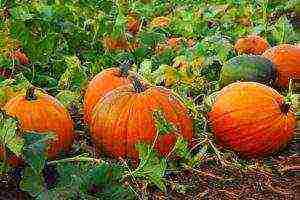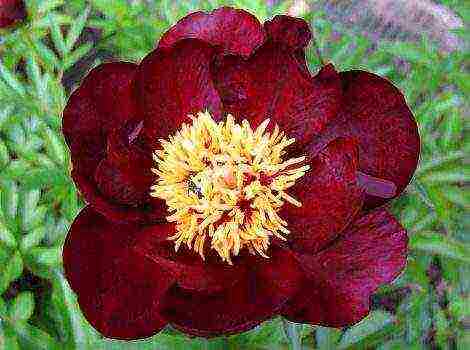Content
- 1 Variety "Sante"
- 2 Variety "Red Scarlett"
- 3 Impala variety
- 4 Variety "Picasso"
- 5 Variety "Condor"
- 6 Variety "Desiree"
- 7 Variety "Jarla"
- 8 Variety "Symphony"
- 9 Variety "Ukama"
- 10 Dutch potatoes "Romano"
- 11 Variety "Prior"
- 12 Variety "Adretta"
- 12.1 Potato variety Red Scarlet
- 12.2 Gala potato variety
- 12.3 Potato variety Timo
- 12.4 Impala potato variety
- 12.5 Potato variety Zhukovsky early
- 12.6 Bellarosa potato variety
- 12.7 Potato variety Luck
- 12.8 Adretta potato variety
- 12.9 Potato variety Romano
- 12.10 Potato variety Nevsky
- 12.11 Rocco potato variety
- 12.12 Potato variety Picasso
- 12.13 Potato variety Aurora
- 12.14 Potato variety Wizard
- 12.15 Potato variety Visa
- 12.16 Potato variety Odyssey
- 12.17 Potato variety Peter's riddle
- 12.18 Potato variety Maestro
- 12.19 Colombo potato variety
- 12.20 Potato variety Scarb
- 12.21 Potato variety Tuleevsky
- 12.22 Potato variety Uladar
- 12.23 Potato variety Breeze
- 12.24 Potato variety Veneta
- 12.25 Riviera potato variety
- 12.26 Jelly potato variety
- 12.27 Potato variety Colette
- 12.28 Potato variety Laura
- 12.29 close on topic:
- 13 Description of the cultivation method
- 14 Potatoes: variety selection (video)
- 15 The best Dutch varieties
- 16 Soil preparation
- 17 Preparation of planting material
- 18 Landing rules
- 19 Further care
- 20 How to plant potatoes (video)
- 21 Reviews and comments
Do not believe that more than 10 (!) Large sacks of potatoes can be collected from one hundred square meters ?! Plant one of the productive varieties of Dutch potatoes on your site and see the reality of these numbers for yourself!
A small area of a personal or suburban area is not a reason to give up growing "second bread" in favor of other crops. It is much more reasonable to allocate the main part of the land allotment for planting the same cucumbers, tomatoes, carrots, strawberries or berry bushes, and occupy one small bed with an over-yielding variety of Dutch potatoes.
The main benefits of Dutch potatoes
The most important advantage of the Dutch potato varieties is their unprecedented yield. So, in temperate latitudes it will not be difficult to get 400-500 centners of elite and super-elite tubers per hectare. If these varieties are grown on the chernozem soils of the south of Russia, then from each hectare it is possible to collect up to 600-800 (!) Centners of selected potatoes.
In Russia, the most widespread are medium-early varieties of Dutch potatoes, whose roots are formed quite early.
Dutch potato varieties, as a rule, are resistant to viruses, various pathogenic types of potato nematodes and cancer, some are not afraid of common scab. But late blight affects the tops of these crops not so rarely, but their tubers are resistant to this disease. To minimize the likelihood of spreading a fungal disease, be sure to treat potatoes with fungicides during the growing season.
Unfortunately, not all Dutch potatoes grow and bear fruit well in our climate. To make it easier for you to choose a good planting material, we offer an overview of 5 high-yielding varieties of Dutch root crops.
Impala
A variety that will delight you with consistently good yields both in cold and hot years. You will find 10 to 20 tubers under each bush.
Oval, covered with a smooth light yellow skin, they are not afraid of mechanical damage, they are perfectly stored and do not germinate for a long time in storage even at high temperatures.
You will also be able to appreciate the taste of this potato. Even after boiling, the tubers retain their color and shape perfectly.
Impala bushes are not very susceptible to nematodes, scab, viral diseases, as well as cancer pathogens.Perhaps the only thing you should be wary of when growing this crop on your site is late blight pathogens. As soon as the leaves of the plants begin to become covered with characteristic spots, the growth of the tubers will stop. In order to prevent such a scenario of the development of events, take preventive measures in time.
| Appointment | Productivity (kg / 100 sq.m) | Tuber weight (g) | Vegetation period (days) | Pulp color |
| 500 | 90-150 | 60-70 | yellow | |
Condor
Condor potatoes have not only a sonorous name, but also good taste. Red tubers with light yellow flesh are great for frying, boiling and baking. Yes, and it is a pleasure to clean them: rather large root crops of the correct oval shape are convenient to hold in your hand. Despite the fact that there are not so many potatoes under the bush, their size is impressive.
Plants tolerate drought well, are resistant to cancer pathogens, but have an average susceptibility to late blight, scab, and viral diseases. Tubers are not afraid of mechanical damage and tolerate winter storage quite well.
| Appointment | Productivity (kg / 100 sq.m) | Tuber weight (g) | Vegetation period (days) | Pulp color |
| 350 | 120-140 | 80-90 | light yellow | |
Latona
If you prefer yellow potatoes, be sure to plant Latona on your site. Most of the oval-round tubers are medium in size, but the weight of some specimens reaches 140 g. Therefore, it is quite simple to collect up to 2.4 kg of tubers from one bush, which are well stored and tolerate transportation.
The growing season of Latona is 70-75 days. Despite this, you can pamper your loved ones with young potatoes already 45 days after planting the tubers.
Plants of this variety have adapted well to the climatic conditions of the middle zone: they are not afraid of either drought or heavy rains. The culture is resistant to viral diseases, as well as golden nematode, dry rot. However, without proper care, the tops of plants can suffer from late blight.
| Appointment | Productivity (kg / 100 sq.m) | Tuber weight (g) | Vegetation period (days) | Pulp color |
| 500 | 90-120 | 70-75 | yellow | |
Red Scarlett
This variety is popular in many countries and is rightfully considered one of the best Dutch varieties of potatoes. Why is he so good?
One of the main advantages of Red Scarlett is its early maturity: you can taste young potatoes as early as 45 days, and start harvesting 75-80 days after planting.
Many gardeners prefer this particular variety because of its high resistance to diseases and pests, mechanical damage, as well as natural disasters, in particular drought. Such "vitality" of plants will allow you to collect good harvests even with minimal care and in the most lean years.
Tubers of this variety have a good presentation. They are of medium to large size, oblong, red in color; their surface is smooth, even with a small number of eyes. The soft yellow pulp does not change its color during cooking and practically does not boil.
| Appointment | Productivity (kg / 100 sq.m) | Tuber weight (g) | Vegetation period (days) | Pulp color |
| 500 | 90–130 | 70-75 | yellow | |
Ukama
The tubers of this variety have an elongated shape and rather large sizes (the weight of the largest potatoes can reach 170 g). When boiled, they do not boil, and the color of their pulp remains the same, light yellow.
Mechanical damage caused to tubers during digging and transportation is quickly tightened and does not affect the keeping quality of the crop.
Plants are not exposed to the invasion of potato nematodes, are not afraid of cancer pathogens, have an average resistance to scab and leaf curling.
The only significant drawback of this variety is that it is not very well adapted to high temperatures. In order to harvest a good potato crop in hot years, you will have to actively water the bushes.
| Appointment | Productivity (kg / 100 sq.m) | Tuber weight (g) | Vegetation period (days) | Pulp color |
| 350 | 120-150 | 50-60 | light yellow | |
The Dutch potato varieties described by us are rightfully considered one of the best in their group. However, they can only reach their potential with proper care. If you
if you want to harvest a large harvest of large and beautiful tubers annually, do not neglect the basic agricultural techniques and do not grow potatoes in the same area for more than 3 years.
The answer to the question why we increasingly prefer Dutch seeds, be it potatoes, cucumbers or tomatoes, is extremely simple. This country with a cool climate is a leader in the production of quality planting material. Potato varieties (Dutch) are some of the best. They are exported to more than 70 countries. Their yield breaks all records. Suffice it to say that in Russia about 100-140 kg of potatoes are harvested from the "hundred", while the Dutch get at least 400 kg from it. This fact is already enough to think about buying. We bring to your attention the most popular potato varieties (photo and description) from Holland.
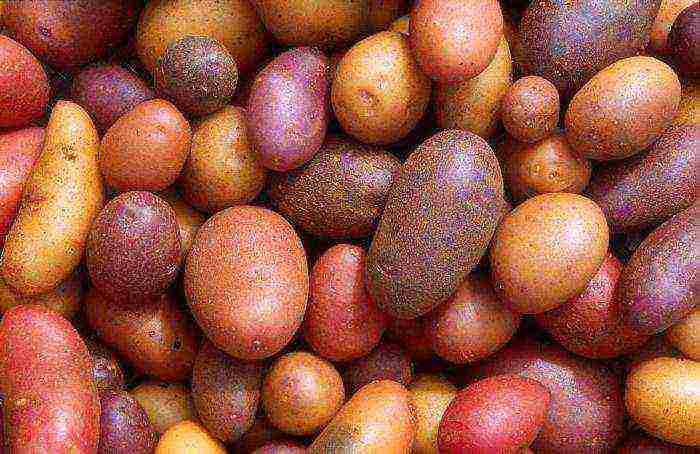
Variety "Sante"
A very productive variety of medium ripening periods (80-90 days) of the selection of the Dutch firm "Agrico". It is actively used to create table dishes, in particular for the preparation of French fries and chips.
The bush grows compact, of medium height, erect. Due to the high yield, a considerable distance must be left between individual plants. The tubers are large, with a characteristic oval shape, with a yellow smooth skin and numerous eyes. The pulp is pale yellow with a starch content of 10-14.2%, high indicators of taste quality.
Sante potatoes are one of the first registered hybrids with complex resistance to viruses and nematodes.
Variety "Red Scarlett"
An early variety with a very high yield of Dutch selection. In the southern regions of the country, the harvest yields in 45 days.
Smooth oblong tubers are red in color and weigh 90-150 g, the surface is even with a small number of eyes, the starch content in them is 10-15%.
One of the main advantages is good drought tolerance, resistance to many viral diseases.
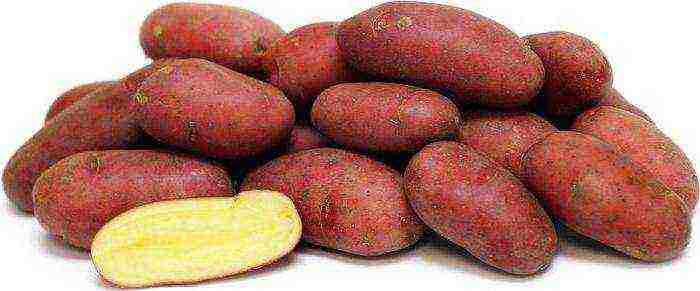
Impala variety
A very early high-yielding variety that allows two harvests over the summer in the southern regions.
The bush is vigorous, high (up to 75 cm), with powerful 4-5 stems, erect. Oval-shaped tubers with yellow skin and pale yellow pulp have a small number of small eyes, starchiness 10-14%, weight on average 90-150 g.
Dutch potatoes of this variety are characterized by good keeping quality, high resistance to bacterial and viral diseases.
Tubers gain weight quickly enough, on average in 50 days, have a beautiful, marketable appearance and high taste.
Variety "Picasso"
Medium-late ripening Dutch potatoes with outstanding taste and long shelf life.
The plant is powerful, tall, with abundant flowering. Oval tubers have a thin yellow rind with pink patches.
Produces a stable and plentiful harvest. However, it is sensitive to poor soils, such potato varieties (Dutch, etc.) require an increased rate of fertilizers to be applied to the soil. Resistant to drought and high air temperatures, viruses, potato nematodes, scab, fusarium, late blight of tubers and tops.
Variety "Condor"
Introduced into culture since 1995. Early variety, table.
The bush is powerful, erect, high. The flowers of the plant are rich, dark red with a purple tint. Oval tubers are even, with red skin and light yellow flesh, starch content in the range of 9-14%.
It is characterized by medium resistance to viruses, common scab, susceptibility to late blight. The variety is valued for its high and stable yield, high marketability of tubers.
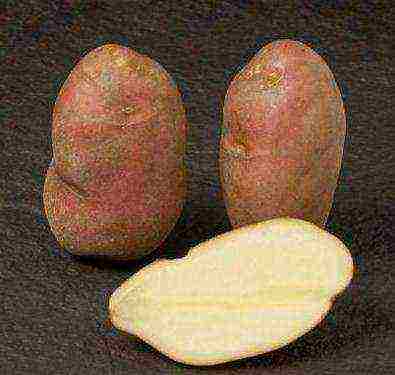
Variety "Desiree"
Potatoes are of medium late ripening.The bush is tall, spreading, with rich green tops. Oval tubers with thin red skin and light yellow pulp, weighing on average up to 100 g. Increased starch content - 13.5-21%.
It is characterized by high taste and is widely used for making chips.
Many modern potato varieties, Dutch in particular, are resistant to drought and various kinds of diseases. "Desiree" in this regard has average indicators, it is susceptible to late blight and scab above average. However, it is high-yielding and has excellent commercial qualities.
Variety "Jarla"
Dutch early table potatoes. Spreading bush, vigorous, white flowers. The tubers have an oval-round shape with a yellow skin and pulp, small eyes. Weight - from 85 to 310 g, high taste, starch index - 12-18%.
This variety allows you to get a bountiful harvest in a short growing season. Rapid maturation provided him with resistance to late blight and rust, scab, and cancer. It develops well on a wide variety of soils, it is not afraid of recurrent frosts - after them the plant quickly returns to normal. The variety has exceptional unpretentiousness and reliability.

Variety "Symphony"
If we consider Dutch potato varieties and others from the point of view of popularity in our country, then "Symphony" will certainly be among the leaders. The border of its cultivation extends from Siberia to the southernmost edges. The variety is a table variety, with a medium-early ripening period (85-115 days).
The tubers are oval in shape, the skin is red and smooth with small eyes, and the flesh is light yellow in color.
It is resistant to late blight, some viral diseases, scab and golden nematode, and is immune to mechanical damage.
Variety "Ukama"
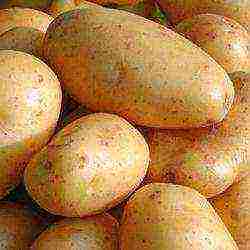
Another very early ripening hybrid. A stable and plentiful harvest can be obtained 90 days after planting, while the first young tubers can be dug out in 50-60 days.
Young potato seedlings and an adult plant are well developed, the bush is large, erect. The tubers have an oval-elongated regular shape, light yellow softness, and have excellent taste. Potatoes are not boiled. The variety is resistant to late blight and nematode.
Dutch potatoes "Romano"
One of the most popular mid-early table varieties. It is appreciated for its high ecological adaptability to growing conditions and the ability to give a stable and high yield, regardless of climatic factors and the nature of the soil.
The tubers are large, their shape is oval-elongated, the peel is pale pink, the flesh is white, the average number in the bush is 9 pcs., Is characterized by a long dormant period, and therefore resistant to germination, has good keeping quality. Potatoes "Romano" are resistant to late blight of tubers, insensitive to scab and some viruses.

Variety "Prior"
This potato variety is characterized by early ripening, good keeping quality of tubers and high yield. Bred relatively recently, but managed to gain popularity among vegetable growers. The tubers are distinguished by an elongated regular shape with a flat surface, a small number of eyes. The pulp is light creamy, the starch content in it is 10-12%. "Prior" - potatoes with complex resistance to viral and bacterial diseases, as well as potato nematode.
Variety "Adretta"
It was registered in 1980 and since then has been very popular with vegetable growers.
The variety is characterized by a medium-early ripening period, complex resistance to bacterial and fungal diseases. The tops are sensitive to late blight. The tubers are large (100-150 g), oval-round in shape with yellow skin and pulp, the eyes are small and few in number.Starch content - 13-18%, high taste.
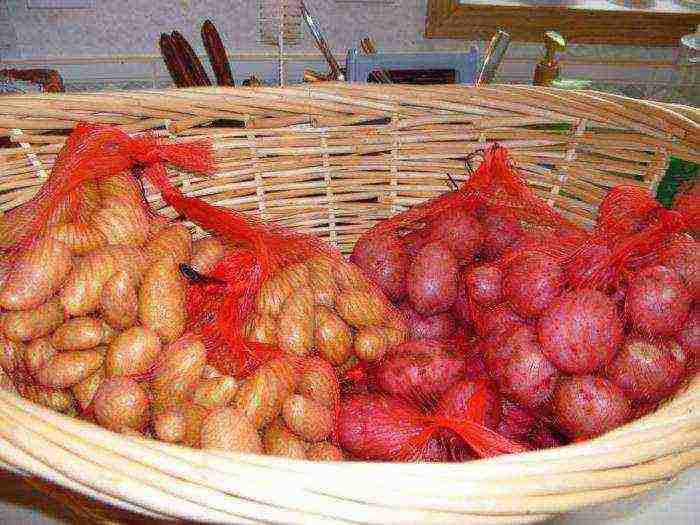
Before planting in the ground, potato seedlings must be prepared and processed - this is the key to a good future harvest.
The purchase of high-quality varietal material has long ceased to be a luxury; rather, it can be called a necessity. Potatoes tend to degenerate and lose their attractive varietal characteristics over the years, but they are capable of acquiring many diseases. For a high and stable yield, the seed fund must be renewed at least once every 3-4 years. It should be noted that Dutch potato varieties (photos and descriptions of some of them are presented above) are traditionally out of competition in this market segment.
The best potato varieties are varieties that are suitable for one or another characteristic, for those who grow them: high yield, disease resistance, unpretentious cultivation, early maturity, taste, marketability and other qualities. There are a great variety of such varieties, therefore, we present the most popular and tested ones.
Potato variety Red Scarlet
Among early varieties potatoes one of the best Dutch varieties should be noted - Red Scarlet... Early ripe variety. From planting to assembly - 75-80 days... The plant is short with reddish-purple flowers. Yield depends on climatic conditions, but enough high 450-600 c / ha... Well suited for the southern regions of the country. Tubers are smooth, oblong, beautiful, have a red color, the size of one potato is 90-130 grams... Smooth, even surface, few eyes.
The main advantage of this variety: does not darken when the surface is damaged, does not change color after cooking. Red Scarlet potatoes easily endure dry summers. It is in great demand and popularity among potato growers. Nice presentation and good taste. Good resistance to nematodes and cancer. Stores well and easily tolerates long-term transportation. With constant planting of its seeds, it retains varietal qualities for a long time.
Flaws: slightly below average resistant to viral diseases, to common scab. When overgrowing, tubers may lose their even shape.
Potato variety Red Scarlet
Gala potato variety
An early variety - Gala. This variety is for table use, of German selection. From the moment of disembarkation of this grade until fully ripe harvest takes place about 80 days... The Gala variety has large leaves, a medium-sized potato bush, weak flowering (white flowers). The weight of one tuber is 80-130 grams. Average yield - 250 kg / ha... Maximum up to 420 c / ha... This variety is very good for sale, as the yield of commercial quality tubers is up to 96%. The tubers are oval, round, even, well suited for mechanical cleaning. The variety is very resistant to diseases and viruses. Good taste. Well stored and transported. Suitable for most regions of our country.
Pros of the Gala variety: unpretentious to soil and climatic conditions, with proper observance of agrotechnical measures - it gives a high yield of high-quality tubers. Resistant to many diseases. Resistance to mechanical damage - high.
Minuses: low resistance to rhizoctonia and late blight. This variety has very few disadvantages, especially if the growing rules are followed.
Gala potato variety
Potato variety Timo
One of the best varieties of early potatoes is considered Timo. Germinates in all regions of Russia, is well stored, high resistance to potato diseases (potato cancer). The yield of this variety is 350-600 kg / ha. Potatoes are medium in size, round in shape, the skin of young potatoes is light in color.
Potato variety Timo
Impala potato variety
Potato variety Impala considered very early, since harvesting can be done 50 days after planting. This variety is in great demand and popularity, especially in the southern regions of our country.Practically in various climatic conditions (drought, abundance of precipitation) - it gives a stable high yield, due to the rapid maturation and use of the spring moisture reserve.
Potato variety Impala, some farms in the Southern regions use for double planting in one season. Bushes are tall with white flowers. Skin color of potato tubers: yellow, shape: oval. This potato variety has a high keeping quality and transportation. Excellent yield of marketable potatoes 85–95%. Resistance to diseases and viruses - high and medium.
Impala potato variety
Potato variety Zhukovsky early
Variety Zhukovsky early belongs to the very early varieties of potatoes. He has a high, stable yield in different climates and different soils. The Zhukovsky variety blooms strongly, with red-purple flowers. A medium-sized bush with numerous shoots. Tubers with pink skin, oval shape. Excellent taste (potato variety is suitable for making chips).
A large yield of marketable tubers (that is, they are all large, small ones are practically absent). This potato variety is resistant to cancer, potato golden nematode, common scab and some other viruses and diseases. It should be noted that the potential yield of the early Zhukovsky variety is 600 c / ha. - this is a very high yield. And the average is 300-400 c / ha.
Potato variety Zhukovsky early
Bellarosa potato variety
Another very early and high yielding potato variety - Bellarosa. The variety is drought tolerant and suitable for most types of soils. The bush is tall with red-violet flowers. Round oval tuber with pink skin. The pulp is light yellow with high palatability. The beautiful presentation and good keeping quality of this variety make it popular and well-sold. Bellorosa potatoes are highly resistant to viral diseases and diseases. Productivity - 320 kg / ha and more.
Bellarosa potato variety
Potato variety Luck
Luck - early maturing, high-yielding potato variety. With the release of marketable tubers up to 100%, good keeping quality and safety in winter. The bushes of the Luck variety are medium-sized with white flowers. Potato tubers are large, oval in shape with a light yellow skin. The pulp is white. Good taste. Feature - planting must be carried out in well-warmed soil. This early ripening potato variety possesses - high resistance to viruses, medium to disease and very resistant to mechanical damage.
Potato variety Luck
Adretta potato variety
Adretta - medium early, high-yielding potato variety with good and high resistance to diseases and viruses. Medium bush with white flowers. Adretta tubers are very well stored without losing their high taste.
Potato variety "Adretta"
Potato variety Romano
Romano - mid-early potato variety. It is one of the best potato varieties of this ripening period due to its high taste (Romano is suitable for cooking any dishes), good stable yield, good keeping quality, is not inclined to intensive germination. Tall plant with red-violet flowers. The tubers are oval, the peel is pink, the flesh is light cream. Average resistance to diseases and viruses. It is affected by common scab, therefore, additional treatments of the Romano variety are needed against it.
Potato variety Romano
Potato variety Nevsky
Mid-early variety Nevsky. Very popular frommid-early, due to the highest yield among Russian varieties. The plant is medium, well branched with a lot of leaves. The flowers are white. The shape of the tubers is oval, the color of the peel is light yellow, the flesh is creamy. High yield of marketable tubers - up to 95%. Keeping quality is good, but at lower storage temperatures, as it has early germination of sprouts.
A feature of the Nevsky variety is planting in warm soil, without injuring tubers and fragments of sprouts. Maintaining an optimal state of soil moisture at the time of tuber formation. Medium and high resistance to viruses and diseases. It responds well to optimal soil fertilization.
Potato variety Nevsky
Rocco potato variety
Rocco - mid-early potato variety with very beautiful red tubers. Plants are medium-sized, erect, with red-violet flowers. Flowering is rare or absent. The tubers are oval with red skin. The pulp is creamy. The yield is high - up to 400 kg / ha. Disease and virus resistance - medium and high. Ideal for retail sales, keeps well and is easy to grow.
Rocco potato variety
Potato variety Picasso
Picasso variety - medium late high-yielding variety of the Dutch selection. Very beautiful tubers, but picky about fertilization. High taste. Stores well. Tall plant with white flowers. Flowering is strong. The tubers are large, oval. The color of the peel is yellow with pink splashes. The yield of marketable tubers is very high, up to 95%. Stores well. Resistance to diseases and viruses is high and very high.
Picasso potato variety
Potato variety Aurora
Aurora - mid-early table potato variety with high palatability. Plant from tall to very tall with reddish-purple flowers. The color of the peel is light brown with red blotches. The pulp is creamy. To diseases and viruses - resistant and moderately resistant.
Potato variety Aurora
Potato variety Wizard
Sorcerer early variety of potatoes with good taste, very resistant to hot climatic conditions. Medium-sized plant with white corollas. The tubers are oval in shape with a yellow and smooth skin. The color of the pulp is white. Keeping quality is very high. Medium resistant to viruses and diseases. High commercial quality.
Potato variety Wizard
Potato variety Visa
Variety Visagrows in the Northern and Middle Volga regions. Potato tubers have a round-oval even shape, a small number of medium-sized eyes. The dense rind has a red tint, inside the flesh is pink or bright yellow. Potatoes are ideal for preparing side dishes and main courses. Productivity up to 500 kg / ha
Potato variety Visa
Potato variety Odyssey
Odysseus- a variety of potatoes with tubers of 95-110 grams, the variety prefers to germinate in the Central Region of Russia. Large tubers have an even oval shape, firm brown skin, light yellow flesh. After boiling, the potato has a soft texture, does not boil over, and has a sweetish taste.
Potato variety Odyssey
Potato variety Peter's riddle
The most common variety for the North-West region of Russia is Peter's riddle... The tubers have a specific oblong oval shape, the peel is pink, the flesh is creamy pink. Potatoes go well with vegetables and meat, and have a sweet taste when cooked. The yield of this variety is small, 180-300 kg / ha. Also this group includes potato varieties: Kolobok and Pyrol. These varieties are perfectly stored in dark rooms throughout the winter, with a yield of 150–220 c / ha.
Potato variety Peter's riddle
Potato variety Maestro
Maestro - table variety of potatoes, easy to prepare, low starch content, about 12%. Productivity up to 155 kg / ha. Smooth medium-sized tubers of light brown color, the flesh is almost white.
Potato variety Maestro
Colombo potato variety
Colombo - an ultra-early variety of potatoes from the Netherlands, characterized by a high and stable yield, excellent taste, evenness of tubers and resistance to most diseases. Medium-sized plants with white flowers can be semi-erect or spreading.Oval tubers, 12 to 15 per nest, have medium and large size, light yellow, smooth peel and yellow, slightly crumbly when cooked, pulp. A month and a half after planting, the potatoes are ready for use, the full cycle of the growing season is 60 days. Shelf life is six months. The yield of this variety reaches 400 kg / ha.
Colombo potato variety
Potato variety Scarb
Mid-season variety from Belarus, Scarb, favorably stands out for its high and stable yield, long shelf life, resistance to scab, blackleg and viral diseases. It sprouts slowly and unevenly, gaining strength over time and turning into semi-sprawling plants of medium height, semi-erect type, with white flowers. Under one bush, there are up to 14 tubers with yellow, dense and smooth skin. The pulp is yellow, watery, poorly boiled. Drought resistance is average, does not tolerate waterlogging of the soil at the beginning of development, is susceptible to late blight. Differs in high yield - 500 - 600 kg / ha.
Potato variety Scarb
Potato variety Tuleevsky
Potato Tuleyevsky - the result of the work of Russian breeders. The mid-early variety is readily grown for private consumption and for commercial purposes on large farms. Semi-upright, medium-sized plant with large white flowers has an incredible yield. The very large oval tubers with mesh skin have a tasty yellowish flesh with a medium starch content. They can be stored without signs of deterioration for a long time. The advantage of the variety is its low susceptibility to viral diseases, potato cancer, scab, late blight and Alternaria. The yield reaches up to 420 kg / ha.
Potato variety Tuleevsky
Potato variety Uladar
Uladar - an early ripe potato variety. bred by Belarusian breeders. Possesses excellent resistance to diseases, high taste characteristics, accelerated formation, resistance of tubers to mechanical stress. Of the minuses: attractiveness for the Colorado potato beetle and exactingness to agricultural technology. Semi-upright plants of medium height, purple flowers with a reddish tint. Potatoes are harvested 65 days after planting. The nest contains 8 to 12 medium and large oval tubers. Under the smooth yellow rind, there is a pale yellow pulp with little digestibility. A very productive variety - 500 - 600 kg / ha.
Potato variety Uladar
Potato variety Breeze
Belarusian potatoes Breeze refers to specimens of medium early maturation. It is characterized as a high-yielding variety (up to 600 c / ha), stable, resistant to impacts and most common diseases. An exception is the golden cyst nematode. Medium-sized, semi-erect plants bloom with white inflorescences. Large oval tubers are covered with a slightly reticulate yellow skin. The yellowish flesh hardly boils well and tastes good. The rapid formation of tubers occurs until the middle of the growing season. It is grown on all types of soils for 70-80 days before harvesting.
Potato variety Breeze
Potato variety Veneta
German ultra early potatoes Veneta deserves the attention of many gardeners due to its excellent immune system and resistance to many diseases. The positive characteristics of the variety also include stable yield, excellent keeping quality and marketability. An erect, spreading, undersized bush, covered with snow-white corollas during flowering, produces up to 15 tubers. Digging can begin one and a half months after disembarkation. Medium-sized oval-round tubers have a yellow, reticulated skin. The pulp is slightly crumbly. Average yield - up to 400 kg / ha.
Potato variety Veneta
Riviera potato variety
Ultra early variety Riviera - the result of Dutch selection. Potatoes are endowed with excellent resistance to viral diseases, high yields and pleasant taste. Medium-sized plants can be semi-erect and spreading, bloom with white flowers. They are characterized by intensive growth at the beginning of development. The variety is suitable for growing under film. Under favorable conditions, it is possible to harvest twice. Each nest grows, on average, 12 light beige oval tubers with a slight roughness of the skin. Creamy pulp is slightly boiled. Productivity - 400 kg / ha.
Riviera potato variety
Jelly potato variety
Potato Jelly medium ripening, originally from Holland, is striking in the content of vitamins, proteins and microelements. Tall, semi-erect or spreading bushes with white flowers give out up to 15 oval-round tubers with a smooth, slightly rough, yellow rind. Dense, dark yellow flesh, practically not boiled soft. Technical maturity occurs in three months. Seed storage can last for several seasons. Jelly is not susceptible to major diseases, only late blight can cause minor damage. The yield can reach up to 500 kg / ha.
Jelly potato variety
Potato variety Colette
Popular potatoes from Germany, Colette, reaches technical maturity in 75 days. This makes it possible to grow a double crop. Germination is recommended. Semi-erect, medium-sized plants bloom with rather large flowers of red-violet color. The distinctive features of the variety include amicable harvest, long shelf life, transportability, low susceptibility to nematodes, suitability for making chips. Smooth elongated tubers are covered with a beautiful yellow rind. The yellowish pulp is a little soft and has an excellent taste. Productivity with proper agricultural technology is 550 c / ha.
Potato variety Colette
Potato variety Laura
Laura - German variety of medium early ripening. Tall, sprawling bushes stand out for their multi-colored flowering - from white to light purple. The red peel effectively sets off the rich yellow color of the pulp, which is very tasty and aromatic. One nest grows up to 20 even, elongated-oval tubers. The crop is harvested no later than 80 days from the time of planting and stored without loss for up to six months. Digging can be done much earlier. Potatoes have good resistance to viral infections and diseases. Undemanding to weather conditions, but hardly tolerates drought. The average yield of the variety is - 300 - 400 c / ha.
Potato variety Laura
It is also worth noting such mid-late varieties as:Gull, Saturn, Valentine, Torch, Story.
Another one of the best representatives of late-ripening potato varieties - Surplus... Geographically, this potato variety grows in the central part of the country. The tubers have a pronounced oblong shape, the peel is yellow, the flesh is light yellow. This variety contains a large amount of starch, up to 25%. Also, this group of late-ripening potato varieties includes: Belorussian, Outflow, Orbit, Pace, Lorch, Olev... They are characterized by the following features: round shape, average tuber size 90–130 grams, white flesh on the cut, not darkening, small eyes on the surface.
Variety of potato varieties
The cultivation of early varieties of potatoes provides the population with this product already in the first half of the summer. Such tubers contain a large amount of vitamin C. Such potatoes are recommended to be eaten in their skins. Longer ripening varieties bring most of the potato harvest. These tubers are high in dry matter, protein and starch.
In order not to be mistaken when choosing a potato variety, it is necessary to study the soil and climatic conditions of places for germinating a crop.There are varieties that germinate well in sandy loam soils, while others - only in fertilized, strong soils. Your result for the winter will depend on the correct choice of the variety. Early varieties are worse stored in winter, they are grown as a "delicacy" for the summer. For late varieties, it is necessary to prepare not only the soil, but also the storage conditions. But with the correct cultivation of late varieties and adherence to all agrotechnical requirements, you will get the highest yield from them with long-term storage under all conditions.
close on topic:
Tomatoes: the best varieties and hybrids
Potato variety Gala: description, features, reviews, photos
Potato variety Red Scarlett: description, characteristics, photos
Potato variety Nevsky: description, characteristics, photos, reviews
Potato variety Luck: description, characteristics, photos, reviews
Cherry variety Shpanka. Description, care features, photo
 In recent years, many domestic potato growers have become interested in planting and growing potatoes using Dutch technology. The Dutch potato varieties are exported to more than seventy countries and successfully combine excellent yields with sufficient resistance to adverse effects.
In recent years, many domestic potato growers have become interested in planting and growing potatoes using Dutch technology. The Dutch potato varieties are exported to more than seventy countries and successfully combine excellent yields with sufficient resistance to adverse effects.
Description of the cultivation method
The cultivation of such an important food crop as potatoes is carried out in most regions of our country. Dutch cultivation technology is of particular interest for potato growing. This modern cultivation method is based on creating conditions for the fastest possible growth and development of the plant. The method is quite simple, but found widespread only over large areas, which is due to some of the features of the technology.
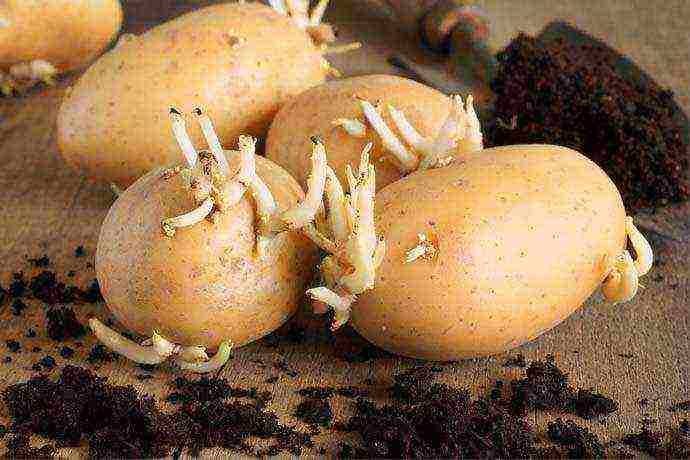
The description of this method of cultivation assumes the maximum reduction in mechanical processing of potatoes at all stages of development. After the formation of high volume ridges, there is no need to continue tillage between the rows. A distinctive feature of the method is the use for the cultivation of productive planting material, which has undergone the whole range of health-improving measures and fully complies with all standards of the standard.
The diameter of tubers used for planting can vary within 3-5 cm. Varietal purity and germination should reach 99-100%. Thus, the basis of the Dutch technology is the high quality of the planting material. Of no small importance is the observance of the planting density and the competent implementation of subsequent care. You should also make the right choice of the variety and evaluate both the advantages and some disadvantages of this method.
Potatoes: variety selection (video)
The best Dutch varieties
The quality characteristics of the planting tubers play an important role when growing potatoes using Dutch technology. Experts and experienced potato growers recommend giving preference to varieties of European, and especially Dutch, selection. Modern Dutch varieties have such advantages as high yields, excellent resistance to diseases and pests. All this allows you to grow the highest quality and highly marketable tubers.
Also read: Growing a peach and nectarine from a stone at home
| Variety name | The ripening period of the crop | Yield indicators | Tuber mass and pulp color | Varietal advantages |
| Impala | About 2-2.5 months | Up to 50 kg from 10 square meters | Weight varies from 90 to 150 g. Very tasty yellow-pulp variety | Low susceptibility to nematodes, scab, as well as viral diseases and the causative agent of cancer |
| "Condor" | Three months | Up to 35 kg from 10 square meters | Weight varies from 125 to 145 g. Red tubers with light yellow flesh | Drought tolerant and cancer-resistant |
| "Latona" | Approximately 2.5 months | Up to 50 kg from 10 square meters | Weight varies from 95 to 125 g. Yellow-fleshed yellow-fruited tubers | Well adapted to the climatic conditions of the middle zone, suitable for transportation and storage |
| Red Scarlet | About 2-2.5 months | Up to 50 kg from 10 square meters | Weight varies from 95 to 135 g. Tubers are reddish in color, with pale yellow flesh | High resistance to diseases and pests, mechanical damage and drought |
| "Ukama" | About two months | Up to 35 kg from 10 square meters | Weight varies from 125 to 155 g. Tubers are yellowish-beige in color, with pale yellow flesh | Resistant to nematode and cancer, as well as mechanical damage |
Soil preparation
Siderates, as well as beets, cabbage, cucumbers and green crops can be good precursors for potato plantings. It is not recommended to plant a vegetable crop after plants belonging to the Solanaceae family. Potatoes are light-loving plants, therefore, in order to maximize uniform illumination, the rows of vegetable crops should be oriented in the direction from north to south.
It should be borne in mind that the Ph-acidity of the soil should be 5.0–5.5. The vegetable crop tolerates growing on acidic soils quite easily, but the yield is higher after liming. Thus, potatoes can be grown on different cultivated soils, but the site must be located without shading and waterlogging.
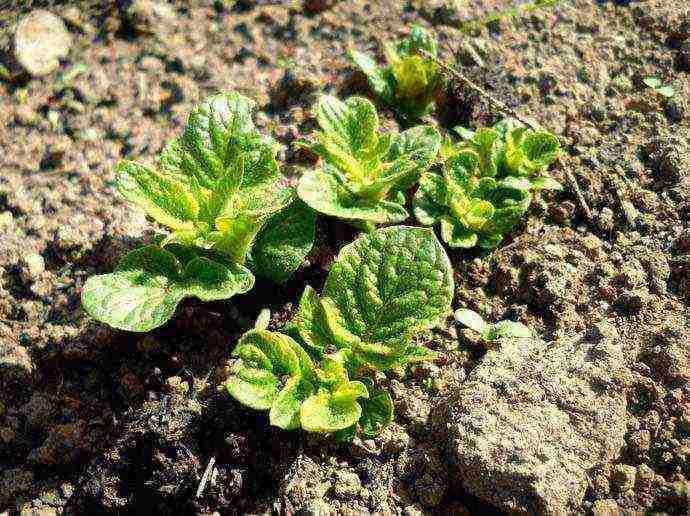
Preparation of planting material
Only high quality and completely healthy potato tubers should be prepared for planting. Preparation for planting involves mandatory warming up, germination and gardening in the sun. A good result is obtained by preplanting seed material with special growth regulators: Epin, Heteroauxin, Zircon, Kornevin, Kresacin, Albit, Immunocytofit.
A very good result is observed when processing planting tubers with a special preparation "Maxim". To stimulate bud germination, a deep enough transverse cut around the tuber should be made on the potato tubers. In this case, it is very important not to touch the pulp tissue in the central part of the tuber. Seed potatoes, ready for planting, have low and strong shoots that cannot break off when the tuber is immersed in the ground and when covered with soil.
If it is impossible to use high-quality planting material, it is imperative to carry out processing in a 1% solution of boric acid for a quarter of an hour. A good result is obtained by heating the tuber in water at a temperature of 40–43 ° С. Planting should be done after warming up the soil. The optimum temperature for growing a vegetable crop is 14-15 ° C.
Landing rules
When carrying out spring plowing, it is necessary to apply nitrogen-containing fertilizer to the soil in the area. Urea has a very good effect on the quality indicators of the soil. In deeply plowed and loosened soil, rows should be made, located in the direction from north to south. It is recommended to deepen the planting material no more than 5–6 cm with a distance of 30 cm between the seed tubers.
A feature of the Dutch technology is the strict adherence to the distance between the rows. Standard row spacing should be 0.75 m, which has a positive effect on the illumination of plants and allows for proper follow-up care of potato plantings. Experienced potato growers recommend pouring a small amount of wood ash and onion husks into the holes when planting, which will scare away slugs and wireworms. The planted seed tubers must be covered with soil and ridges with a height of about 10-12 cm should be formed, which will serve as a shelter for potato plantations.
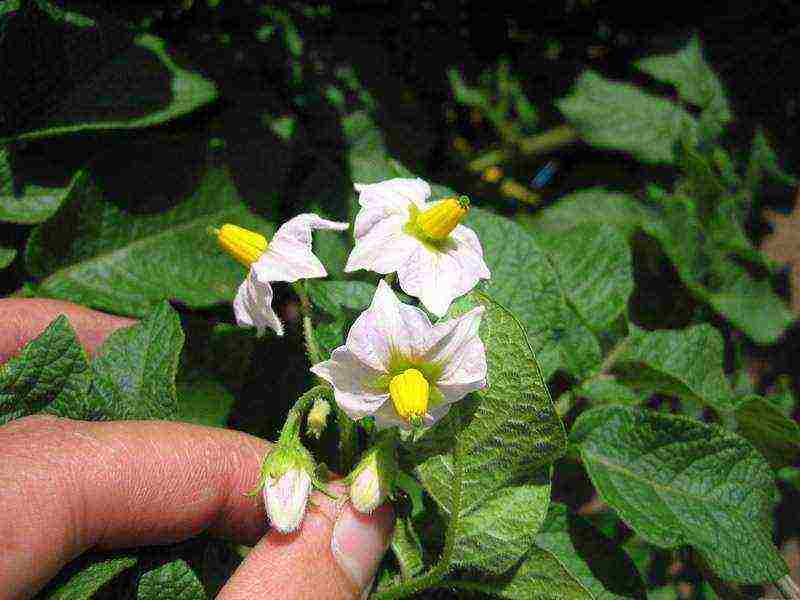
Further care
Care activities are simple:
- after the emergence of seedlings, the first inter-row cultivation of potatoes is carried out to destroy weeds and improve the formation of potato tubers;
- it is necessary to fill up potato sprouts with well-loosened soil between rows, which will increase the height of the ridges to 20-22 cm;
- irrigation activities are carried out through the use of a drip irrigation system;
- the buds on the plants must be torn off, which will not allow the potato to waste energy and nutrition on the formation of seeds;
- in order to protect against phytophthora and damage by alternariosis, potatoes should be sprayed two or three times with such preparations as "Fitosporin-M", "Bordeaux liquid", "Ordan", "Kurzat".
How to plant potatoes (video)
Potatoes are a very fertile and plastic vegetable crop. Low yields in Russian growing conditions are often explained by ignorance of the botanical characteristics of this crop, as well as the use of random planting material from low reproductions for growing and significant violations of the cultivation technology.
Attention, only TODAY!
Reviews and comments
Did you find a mistake in the text? Please select it and press Ctrl + Enter. Thank you!
Rating:
(
estimates, average:
out of 5)
